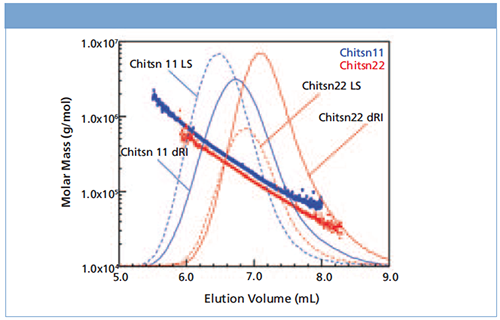Absolute Molar Mass Analysis of Chitosans
Chitosans are analyzed by SEC-MALS to determine molar mass moments and distributions.
Chitosans are analyzed by SEC-MALS to determine molar mass moments and distributions.
Chitin is one of the most abundant biopolymers on earth (the other is cellulose). Chitin, or poly-N-acetylglucosamine, is the major polymer in the exoskeleton of marine arthropods and can also be found in fungi and yeasts.
Chitosan is deacetylated chitin. It can be obtained from shrimp or crab shells. Its applications vary from the therapeutic, such as wound healing, to cosmetics and dietary supplements.
For many of these applications, it is useful to fully characterize the molar mass moments and distributions of the chitosan products. Size-exclusion chromatography in combination with multi-angle light scattering detection (SEC-MALS) provides an easy method to obtain these properties in an absolute manner, free of molecular references. In this note, we describe the results for two chitosan samples analyzed by SEC-MALS.
Experimental Conditions
A DAWN® MALS detector (Wyatt Technology) and an Optilab® differential refractive index (dRI) detector (Wyatt Technology) were plumbed downstream of the GPC column. Data collection and analysis were performed in the ASTRA® software (Wyatt Technology) using empirically determined differential refractive index increments (dn/dc). Polymer molar mass, M, was calculated at each elution volume using signals from the two detectors.
The differential refractive index is a property of the polymer and solvent system. It is measured by injecting a series of known concentrations into the Optilab, using solutions that are often prepared by the dry weight method for accuracy, and the GPC mobile phase as solvent. ASTRA collects and analyzes the results to determine dn/dc.
Results
The molar masses of two chitosan samples were plotted as a function of elution volume in Figure 1. The molar mass decreases logarithmically, indicating that chromatographic conditions were optimal. The offset in elution volume for a given molar mass may be a result of conformation (short-chain branching, SCB) or non-ideal analyte-column interaction. SCB may be further investigated by making use of simultaneous size (radius of gyration, Rg) and molar mass analysis by MALS.
Figure 1: Molar mass vs. elution volume plots superimposed over chromatograms.

A cumulative molar mass distribution plot, depicted in Figure 2, clearly differentiates the two chitosan samples. ASTRA software can also report weight fractions above, below, or between the molar masses of interest. As an example, the weight fraction of molar masses below 50 kDa and above 500 kDa for these samples are given in the table in Figure 2. These calculations and the cumulative molar mass distribution plot are ideal for quality control applications.
Figure 2: Cumulative molar mass distribution plot of two chitosan samples with quite different spans.

Conclusions
The results described herein show that MALS detection combined with SEC provides an indispensable tool for biopolymer characterization. Absolute molar mass and molar mass distribution can be readily obtained without the use of any standards or empirical relations, simplifying QC and routine analyses while enhancing inâdepth analysis with absolute measurements of size as well as molar mass.

Wyatt Technology
6330 Hollister Avenue, Santa Barbara, California 93117, USA
Tel.: +1 (805) 681 9009
Website: www.wyatt.com

Automated Sample Preparation (ISO 20122) for MOSH/MOAH in Seasoning Oils
May 6th 2025This work presents an Automated Sample Preparation procedure for MOSH/MOAH analysis of Seasoning Oils. We compare results from a manual epoxidation procedure compliant with DIN 16995 with results based on fully automated sample preparation (epoxidation and saponification) compliant with ISO 20122. In both cases, online clean-up via activated aluminum oxide (AlOx) are used to remove interfering n-alkanes from the MOSH fraction during the HPLC run. Automated data evaluation using a dedicated software (GERSTEL ChroMOH) is presented.
Free Poster: NDSRI Risk Assessment and Trace-Level Analysis of N-Nitrosamines
April 25th 2025With increasing concern over genotoxic nitrosamine contaminants, regulatory bodies like the FDA and EMA have introduced strict guidelines following several high-profile drug recalls. This poster showcases a case study where LGC and Waters developed a UPLC/MS/MS method for quantifying trace levels of N-nitroso-sertraline in sertraline using Waters mass spectrometry and LGC reference standards.

.png&w=3840&q=75)

.png&w=3840&q=75)



.png&w=3840&q=75)



.png&w=3840&q=75)








